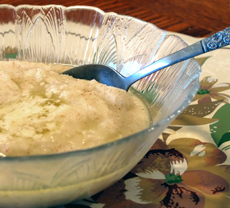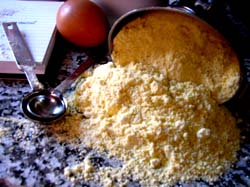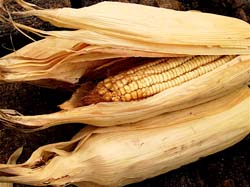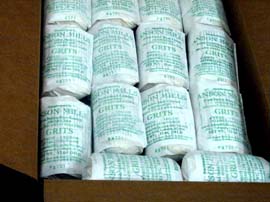
 Delicious, creamy grits are incorporated into sophisticated dinner plates by America’s top chefs—as well as enjoyed for breakfast with eggs and toast. Delicious, creamy grits are incorporated into sophisticated dinner plates by America’s top chefs—as well as enjoyed for breakfast with eggs and toast.
|
ROWANN GILMAN is on the editorial staff of THE NIBBLE.
|
|
March 2005
Updated November 2009
|
 |
Anson Mills Grits
Southern Heirloom Organic Grits
If you don’t like grits, you’ve never had the real deal. Anson Mills’ honest-to-the-core organic antebellum sweet Carolina corn grits are far from the gluey, pallid tasteless beds for butter pats many people know and pass on. They’re cold-milled grits, handmade from certified organic whole heirloom seed corn. For pure yet mild sweet corn flavor coaxed to the fore by one to two hours of slow cooking (we start them with the local news and cook them until the end of Jeopardy), go for Anson’s Fresh Native Stoneground Rosebank Gold coarse-ground mixed yellow and white grits.
Anson mills its grits—and dozens more “historic” grains including buckwheat polenta, cornmeal, johnnycake meal and all sorts of flours—exclusively from antique and heirloom seeds gathered from a host of secretly sought-out local farms where families have grown crops from them for generations. These grains were on the verge of extinction, and Anson Mills has been the driving force in bringing back old and nearly extinct species of heirloom corn.
Anson’s grits have such unique body, texture and sweet corn integrity that you might just decide to nix the usual butter/cheese mix-ins and go for a real down-south grits experience (great grits know no hour: they love you at breakfast, lunch and dinner…and left over the next day). Small wonder that chefs like Lydia Bastianich, Thomas Keller, Charlie Trotter, and Jean Georges Vongerichten are loyal Anson customers.
Try them for yourself and you’ll be overwhelmed by the full-flavor taste of these organic heirloom grains. Anson Mills produces very coarse grits with fresh germ and meal separated, sifted, cleaned and mixed by hand in final product to preserve fresh corn flavor, texture, nutrients and richness with the added floral flavors from fresh corn germ. This style of grits was popular before the Civil War and was still available fresh ground every Saturday morning in downtown Charleston, SC, before World War II. Now, every year at the International Grits Festival in St. George, South Carolina, thousands of grits fans line up to get fresh milled hominy grist right out of the mill.
|

While not connected to Anson’s, this old grist mill at Dew’s Pond in Calhoun, Georgia is used for grinding local corn for cornmeal and hominy for grits. Antebellum Hominy Grist was produced everywhere in Carolina and Georgia. There was an average of 40 mills per county before 1860. They milling fresh corn, then winnowed out only the hull to preserve whole corn nutrients, flavor & texture. Photo courtesy of MorgueFile.com. |
Anson Mills grits are perishable and must be refrigerated or frozen.
A Brief Grits Vocabulary
GRIST: Everything that comes out of a stone mill when milling grain.
GRITS or HOMINY GRITS: The hard part of the corn kernel (endosperm), cut into  uniform small pieces, about 1/16th to 1/20th of an inch across, and separated from the corn meal, corn flour, corn germ and hull. Hominy grits are another form of hominy, produced by grinding the dried and processed corn kernels several times into a finer grained substance to be sold as fine, medium, or coarse textured hominy. Grits are often combined with milk and water and traditionally served in the southern U.S. as pudding, as a side dish, or made into squares and fried. Historically, white corn was popular in the urban port cultures of the South (Wilmington, Charleston, Savannah, New Orleans) that were settled by Europeans with a predilection for white mill goods. Moving inland through the rural American South, yellow corn—and grits—predominated. White corn possesses more pronounced mineral and floral nuances; yellow corn is more robust with citrus flavor at the back of the palate. (Photo above: Anson Mills yellow grits) uniform small pieces, about 1/16th to 1/20th of an inch across, and separated from the corn meal, corn flour, corn germ and hull. Hominy grits are another form of hominy, produced by grinding the dried and processed corn kernels several times into a finer grained substance to be sold as fine, medium, or coarse textured hominy. Grits are often combined with milk and water and traditionally served in the southern U.S. as pudding, as a side dish, or made into squares and fried. Historically, white corn was popular in the urban port cultures of the South (Wilmington, Charleston, Savannah, New Orleans) that were settled by Europeans with a predilection for white mill goods. Moving inland through the rural American South, yellow corn—and grits—predominated. White corn possesses more pronounced mineral and floral nuances; yellow corn is more robust with citrus flavor at the back of the palate. (Photo above: Anson Mills yellow grits)
HOMINY: A food made by soaking whole corn in slaked lime solution to remove the germ and hull. A corn product that is created by soaking white or yellow corn kernels in scalding water mixed with a chemical solution, such as a mild lye or slaked lime. The soaking forces the kernel to expand so the hull and germ split. This allows the kernel to be easily removed so that the remaining corn substance can be dried. |

Anson Mills Hickory King white hominy corn . |
After it has been dried, the whole kernels are soaked in water and a solution mixed with limestone or wood ash to expand the kernels, which are then boiled, creating a soft puffy food product. Hominy is the Colonial English spelling of the sound of the oral Native American word for corn. Charlestonians have always called fresh whole ground corn grits “hominy,” a shortened version of the old Carolina term for whole corn “hominy grist.”
ANSON MILLS GRITS
Antebellum-Style Coarse Grind Grits
Anson Mills is a USDA Certified Organic Farm and Processor
- 10# Single Bag
$50.00
- 12-Ounce Bags
$5.95 each
(4-bag minimum of any
products, can store frozen)
Purchase by phone from Anson
Mills: 1.803.467.4122
E-mail: Sales@AnsonMills.com
AnsonMills.com
|

Buy enough 12-ounce bags to make yourself and several of your friends very happy. Grits freeze beautifully. |
Price is verified at publication but is subject to change.
Lifestyle Direct, Inc. All rights reserved. Images are the copyright of their respective owners.

|




 uniform small pieces, about 1/16th to 1/20th of an inch across, and separated from the corn meal, corn flour, corn germ and hull. Hominy grits are another form of hominy, produced by grinding the dried and processed corn kernels several times into a finer grained substance to be sold as fine, medium, or coarse textured hominy. Grits are often combined with milk and water and traditionally served in the southern U.S. as pudding, as a side dish, or made into squares and fried. Historically, white corn was popular in the urban port cultures of the South (Wilmington, Charleston, Savannah, New Orleans) that were settled by Europeans with a predilection for white mill goods. Moving inland through the rural American South, yellow corn—and grits—predominated. White corn possesses more pronounced mineral and floral nuances; yellow corn is more robust with citrus flavor at the back of the palate. (Photo above: Anson Mills yellow grits)
uniform small pieces, about 1/16th to 1/20th of an inch across, and separated from the corn meal, corn flour, corn germ and hull. Hominy grits are another form of hominy, produced by grinding the dried and processed corn kernels several times into a finer grained substance to be sold as fine, medium, or coarse textured hominy. Grits are often combined with milk and water and traditionally served in the southern U.S. as pudding, as a side dish, or made into squares and fried. Historically, white corn was popular in the urban port cultures of the South (Wilmington, Charleston, Savannah, New Orleans) that were settled by Europeans with a predilection for white mill goods. Moving inland through the rural American South, yellow corn—and grits—predominated. White corn possesses more pronounced mineral and floral nuances; yellow corn is more robust with citrus flavor at the back of the palate. (Photo above: Anson Mills yellow grits) 
